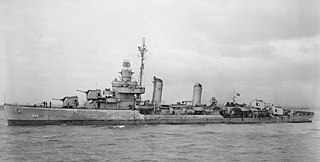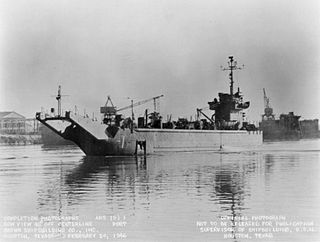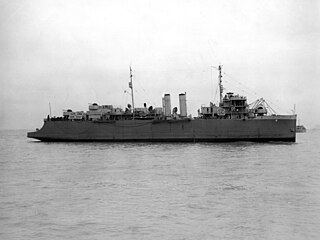
USS Abnaki (ATF-96) was the lead ship of the Abnaki class of fleet ocean tugs in the service of the United States Navy, named after the Abenaki tribe of Native Americans. She was laid down on 28 November 1942 at Charleston, South Carolina by Charleston Shipbuilding & Drydock, launched on 22 April 1943, sponsored by Mrs. James Mayon Jones, and commissioned at the Charleston Navy Yard on 25 November 1943. Abnaki earned three battle stars for service during the Korean War and 10 battle stars during the Vietnam War.

USS Knight (DD-633), a Gleaves-class destroyer, is the only ship of the United States Navy to be named for Admiral Austin M. Knight.
USS Chickadee (AM-59) was an Auk-class minesweeper of the United States Navy, named after the Chickadee, a family of small passerine birds which appear in North America and Africa.

USS Gypsy was the lead ship of her class of salvage lifting vessels serving in the United States Navy. Originally designated LSM-549, she was launched by Brown Shipbuilding Corporation, Houston, Texas, on 7 December 1945, and commissioned on 18 March 1946 at Houston.

USS Mender was a Gypsy-class salvage lifting vessel of the United States Navy. Originally designated LSM‑550, she was reclassified on 24 April 1945, and was laid down on 25 August 1945 by Brown Shipbuilding Corporation, Houston, Texas. Launched on 7 December 1945; and commissioned on 8 March 1946.
USS Symbol (AM-123) was an Auk-class minesweeper acquired by the United States Navy for the dangerous task of removing mines from minefields laid in the water to prevent ships from passing.
USS Pilot (AM-104) was a United States Navy Auk-class minesweeper that saw service in the Mediterranean and Pacific Theaters of Operations during World War II.

USS Rail (AM-26/AT-139/ATO-139) was a Lapwing-class minesweeper built for the United States Navy during World War I. She was the first U.S. Navy ship named for the rail, a small wading bird, related to the cranes.

USS Brant (AM-24) was a Lapwing-class minesweeper in the United States Navy during World War II. She was named by the U.S. Navy for the brant, a small goose.

USS Grebe (AM-43) was a Lapwing-class minesweeper in the United States Navy.
USS Redwing is a name the United States Navy has used more than once in naming its vessels:

USS Salem (CM-11) was a commercial cargo ship, that served as a minelayer and then net laying ship of the United States Navy during World War II.

USS Weehawken (CM-12) was originally SS Estrada Palma – a car ferry built in 1920 by William Cramp & Sons of Philadelphia. It was acquired by the United States Navy on 15 June 1942; renamed Weehawken on 18 July 1942; converted to a minelayer by the Bethlehem Steel Co. at Hoboken, New Jersey; designated CM-12; and commissioned on 30 September 1942.

USS Sellstrom (DE-255) was an Edsall-class destroyer escort built for the U.S. Navy during World War II. She served in the Atlantic Ocean, the Pacific Ocean and provided destroyer escort protection against submarine and air attack for Navy vessels and convoys.

USS Strickland (DE-333) was an Edsall-class destroyer escort in service with the United States Navy from 1944 to 1946 and from 1952 to 1959. She was sold for scrapping in 1974.

USS Moreno (AT-87) was a Navajo-class fleet tug constructed for the United States Navy during World War II. Her purpose was to aid ships, usually by towing, on the high seas or in combat or post-combat areas, plus "other duties as assigned." She served in the Atlantic Ocean and, at war's end, returned home with three battle stars to her credit.
USS Tackle (ARS-37) was a Tackle-class rescue and salvage ship acquired by the U.S. Navy during World War II. She served in North Atlantic waters, and returned home at war's end with two battle stars.

USS Diver (ARS-5) was a Diver-class rescue and salvage ship commissioned by the U.S. Navy for service in World War II. She was responsible for coming to the aid of stricken vessels.
Rescue and salvage ships are a type of military salvage tug. They are tasked with coming to the aid of stricken vessels. Their general mission capabilities include combat salvage, lifting, towing, retraction of grounded vessels, off-ship firefighting, and manned diving operations. They were common during World War II.
USS Extricate (ARS-16) was an Anchor-class rescue and salvage ship commissioned by the U.S. Navy during World War II. Her task was to come to the aid of stricken vessels.













